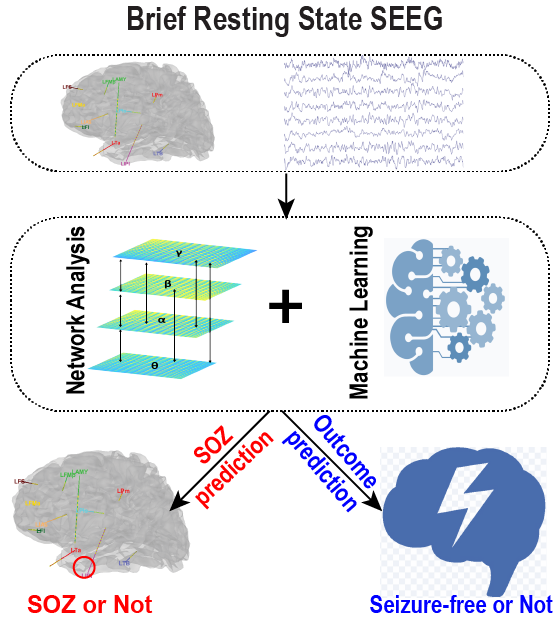Epilepsy is one of the most common neurological diseases, impacting about 70 million people globally. At least one-third of epilepsy patients become drug-resistant and potential candidates for surgical resection or treatment using neuromodulation. The key to successful epilepsy surgery relies on accurate localization and safe removal of the epileptogenic zone (EZ). An integral component for the delineation of the EZ is the seizure onset zone (SOZ) which is the area of the cortex that initiates clinical seizures and is determined predominantly by intracranial investigation. Although surgery and neuromodulation have been proven effective in seizure reduction, there is still a significant room for improvement.
Stereotactic-electroencephalography (SEEG) is a well-established and safe neurosurgical approach to record ictal/interictal brain activity.The golden standard of localization of epileptogenic brain regions in clinical practice typically depends on capturing multiple seizures during the intracranial monitoring process. This may take multiple days or even weeks to complete. As such, a method which can estimate the SOZ and predict prognosis outcomes from the analysis of brief, resting-state data segments, would have tremendous clinical value and represent a significant step forward.
In May 2022, Haiteng Jiang and his team from the BBMI/Mental Health Center, Affiliated to the School of Medicine of Zhejiang University (Hangzhou Seventh People's Hospital), published their latest research results in Advanced Science. This research may negate the troublesome requirement for prolonged monitoring of seizure signals during the diagnosis and treatment of epilepsy. Using ten-minute resting-state Stereotactic-electroencephalography (SEEG), combined with advanced brain network analysis methods and machine learning algorithms, they developed a new method to localize the SOZ and predict prognosis outcome with an accuracy of 90% (Figure 1).

Interictal SEEG Resting-State Connectivity Localizes the Seizure Onset Zone and Predicts Seizure Outcome
With a cohort of 27 drug-resistant epilepsy patients, the team were able to estimate the information flow via directional connectivity and inferred the excitation-inhibition ratio from the 1/f power slope. They hypothesized that the antagonism of information flow at multiple frequencies between SOZ and non-SOZ brain areas would underly the relatively stable epilepsy resting state and could be used to indicate the related disrupted excitation-inhibition balance that characterizes epilepsy. Furthermore, they speculated that the strength of antagonisms would reflect the intrinsic epileptic network characteristics, which could then be eventually associated with seizure outcome. The team found more excitability in non-SOZ regions compared to the SOZ, with dominant information flow from non-SOZ to SOZ regions. Greater differences in resting-state information flow between SOZ and non-SOZ regions were clearly associated with favorable seizure outcome. By integrating a balanced random forest model with the resting-state connectivity, their method localized the SOZ with an accuracy of 88% and predicted the seizure outcomes with an accuracy of 92%, using a clinically determined SOZ.
Overall, this study suggests that brief resting-state SEEG data can significantly facilitate the identification of SOZ and may eventually facilitate the prediction of seizure outcomes without requiring long-term ictal recordings.




 Location :
Location : 

